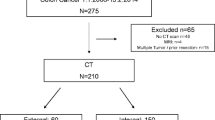Summary
The correlation of the preoperative staging by CT with the post-operative staging was prospectively investigated in 112 patients with carcinoma of the rectum. The influence of CT on the choice of surgical treatment was also proven. The evaluation of the infiltration of perirectal tissue and especially of other organs is possible with CT. According to TNM classification the pre- and postoperative staging showed identical results by conventional diagnostic methods in T1 in 7/16, in T2 in 22/38, in T3 in 37/49 and in T4 in 5/9 patients. With the additional CT identical results were found in T1 in 7/14, in T2 in 25/31, in T3 in 49/53 and in T4 in 13/14 cases. Thus, the preoperative staging turned out to be correct with CT in 94/112 cases (83.9%). By conventional diagnostic methods identical results were found in 71/112 patients (63.4%). The infiltration of other organs was suspected preoperatively in 24 cases with CT and was found intraoperatively in 30/112 (accuracy 94.6%, sensitivity 88%, specificity 96%). Metastases of lymph nodes were suspected in the tomograms in 32/49 patients (65.3%). By the differentiated interpretation of the tumor growth with special regard to the “Grenzlamellen” of the rectum the CT gives important information for planning therapy.
Zusammenfassung
In einer prospektiven Studie wurde bei 112 Patienten mit Rectumcarcinom die Korrelation des präoperativen Stagings mit CT zum intra- bzw. postoperativen Befund und ihr Einfluß auf die chirurgische Verfahrenswahl geprüft. Durch die CT wird eine Beurteilung des infiltrativen Tumorwachstums und besonders eine Infiltration benachbarter Organe möglich. Der Vergleich des prä- und postoperativen Stagings nach der TNM-Klassification brachte nach konventioneller Diagnostik im Stadium T1 bei 7/16, in T2 bei 22/38, in T3 bei 37/49 und in T4 bei 5/9 Patienten übereinstimmende Ergebnisse. Nach zusätzlicher Computertomographie stimmten prä- und postoperativ die Stadien in T1 bei 7/14, in T2 bei 25/31, in T3 bei 49/53 und in T4 bei 13/14 Patienten überein. Insgesamt wurde das Tumorstadium präoperativ ohne CT bei 71 (63,4%) und nach Erweiterung der Diagnostik mit CT bei 94/112 Patienten (83,9%) richtig eingestuft. Eine Infiltration benachbarter Organe wurde präoperativ im CT bei 24 vermutet und bei 30/112 Patienten intraoperativ nachgewiesen (Richtigkeit 94,6%, Sensitivität 88%, Spezifität 96%). Lymphknotenmetastasen wurden bei 32/49 Patienten (65,3%) bereits präoperativ vermutet. Durch die differenzierte Betrachtung des Tumorwachstums unter besonderer Berücksichtigung der Grenzlamellen gibt die CT wichtige Informationen für die Therapieplanung.
Similar content being viewed by others
Literatur
Dixon AK, Fry IK, Morson BC, Path FRC, Nicholls RJ, Mason AY (1981) Preoperative computed tomography of carcinoma of the rectum. Br J Radiol 54:655–659
Dukes CE (1932) The classification of cancer of the rectum. J Pathol Bacteriol 35:323–332
Ellert J, Kreal L (1980) The value of CT in malignant colonic tumors. CT 4:225–240
Feifel G, Hildebrandt U, Dhom G (1985) Die endorectale Sonographie beim Rectumcarcinom. Chirurg 56:398–402
Grabbe E, Lierse W, Winkler R (1982) Hüllfascien des Rektums. Fortschr Röntgenstr 136:653–659
Hamlin DJ, Burgener FA, Sisohy B (1981) New technic to stags early rectal carcinoma by computed tomography. Radiology 141:539–540
Hermanek P (1985) Erlangen, persönl. Mitteilung
Husband JE, Hodson NJ, Parsons CA (1980) The use of computed tomography in recurrent rectal tumors. Radiology 134:677–682
Koehler PR, Feldberg MA, van Waes PFGM (1984) Preoperative staging of rectal cancer with computerized tomography. Cancer 54:512–516
Ruedi F, Thoeni MD, Moss AA, Schnyder P, Margulis A (1981) Detection and staging of primary rectal and rectosigmoid cancer by computed tomography. Radiology 141:135–138
Ruf G, Brobmann GF, Grosser G, Wimmer B (1985) Wert der Computertomographie für die Beurteilung der lokalen Operabilität und die chirurgische Verfahrenswahl beim Oesophaguscarcinom. Langenbecks Arch Chir 365:157–168
Ruf G, Kirste G, Grosser G, Wimmer B, Fiedler L (1985) Stellenwert der Computertomographie in der Diagnostik des Magenkarzinoms aus chirurgischer Sicht. Aktuel Chir 20:55–60
UICC-TNM-Atlas (1985) Illustrated guide to the classification of malignant tumors. Springer, Berlin Heidelberg New York Tokyo
van Waes PFGM, Koehlen PR, Feldberg MA (1983) Management of rectal carcinoma; Impact of computed tomography, Am J Radiol 140:1137–1141
Zaunbauer W, Haertel M, Fuchs WA (1981) Computed tomography in carcinoma of the rectum. Gastrointest Radiol 6:79–84
Author information
Authors and Affiliations
Rights and permissions
About this article
Cite this article
Ruf, G., Hauensteina, K.H., Rudolf, M. et al. Präoperatives Staging des Rectumcarcinoms mit der Computertomographie. Langenbecks Arch Chiv 368, 3–11 (1986). https://doi.org/10.1007/BF01261297
Received:
Published:
Issue Date:
DOI: https://doi.org/10.1007/BF01261297




